Yujie Chen
Mitigating Audiovisual Mismatch in Visual-Guide Audio Captioning
May 28, 2025Abstract:Current vision-guided audio captioning systems frequently fail to address audiovisual misalignment in real-world scenarios, such as dubbed content or off-screen sounds. To bridge this critical gap, we present an entropy-aware gated fusion framework that dynamically modulates visual information flow through cross-modal uncertainty quantification. Our novel approach employs attention entropy analysis in cross-attention layers to automatically identify and suppress misleading visual cues during modal fusion. Complementing this architecture, we develop a batch-wise audiovisual shuffling technique that generates synthetic mismatched training pairs, greatly enhancing model resilience against alignment noise. Evaluations on the AudioCaps benchmark demonstrate our system's superior performance over existing baselines, especially in mismatched modality scenarios. Furthermore, our solution demonstrates an approximately 6x improvement in inference speed compared to the baseline.
Hearing from Silence: Reasoning Audio Descriptions from Silent Videos via Vision-Language Model
May 19, 2025Abstract:Humans can intuitively infer sounds from silent videos, but whether multimodal large language models can perform modal-mismatch reasoning without accessing target modalities remains relatively unexplored. Current text-assisted-video-to-audio (VT2A) methods excel in video foley tasks but struggle to acquire audio descriptions during inference. We introduce the task of Reasoning Audio Descriptions from Silent Videos (SVAD) to address this challenge and investigate vision-language models' (VLMs) capabilities on this task. To further enhance the VLMs' reasoning capacity for the SVAD task, we construct a CoT-AudioCaps dataset and propose a Chain-of-Thought-based supervised fine-tuning strategy. Experiments on SVAD and subsequent VT2A tasks demonstrate our method's effectiveness in two key aspects: significantly improving VLMs' modal-mismatch reasoning for SVAD and effectively addressing the challenge of acquiring audio descriptions during VT2A inference.
$\mathcal{A}LLM4ADD$: Unlocking the Capabilities of Audio Large Language Models for Audio Deepfake Detection
May 16, 2025Abstract:Audio deepfake detection (ADD) has grown increasingly important due to the rise of high-fidelity audio generative models and their potential for misuse. Given that audio large language models (ALLMs) have made significant progress in various audio processing tasks, a heuristic question arises: Can ALLMs be leveraged to solve ADD?. In this paper, we first conduct a comprehensive zero-shot evaluation of ALLMs on ADD, revealing their ineffectiveness in detecting fake audio. To enhance their performance, we propose $\mathcal{A}LLM4ADD$, an ALLM-driven framework for ADD. Specifically, we reformulate ADD task as an audio question answering problem, prompting the model with the question: "Is this audio fake or real?". We then perform supervised fine-tuning to enable the ALLM to assess the authenticity of query audio. Extensive experiments are conducted to demonstrate that our ALLM-based method can achieve superior performance in fake audio detection, particularly in data-scarce scenarios. As a pioneering study, we anticipate that this work will inspire the research community to leverage ALLMs to develop more effective ADD systems.
Q-MambaIR: Accurate Quantized Mamba for Efficient Image Restoration
Mar 27, 2025Abstract:State-Space Models (SSMs) have attracted considerable attention in Image Restoration (IR) due to their ability to scale linearly sequence length while effectively capturing long-distance dependencies. However, deploying SSMs to edge devices is challenging due to the constraints in memory, computing capacity, and power consumption, underscoring the need for efficient compression strategies. While low-bit quantization is an efficient model compression strategy for reducing size and accelerating IR tasks, SSM suffers substantial performance drops at ultra-low bit-widths (2-4 bits), primarily due to outliers that exacerbate quantization error. To address this challenge, we propose Q-MambaIR, an accurate, efficient, and flexible Quantized Mamba for IR tasks. Specifically, we introduce a Statistical Dynamic-balancing Learnable Scalar (DLS) to dynamically adjust the quantization mapping range, thereby mitigating the peak truncation loss caused by extreme values. Furthermore, we design a Range-floating Flexible Allocator (RFA) with an adaptive threshold to flexibly round values. This approach preserves high-frequency details and maintains the SSM's feature extraction capability. Notably, RFA also enables pre-deployment weight quantization, striking a balance between computational efficiency and model accuracy. Extensive experiments on IR tasks demonstrate that Q-MambaIR consistently outperforms existing quantized SSMs, achieving much higher state-of-the-art (SOTA) accuracy results with only a negligible increase in training computation and storage saving.
HeightFormer: Learning Height Prediction in Voxel Features for Roadside Vision Centric 3D Object Detection via Transformer
Mar 13, 2025


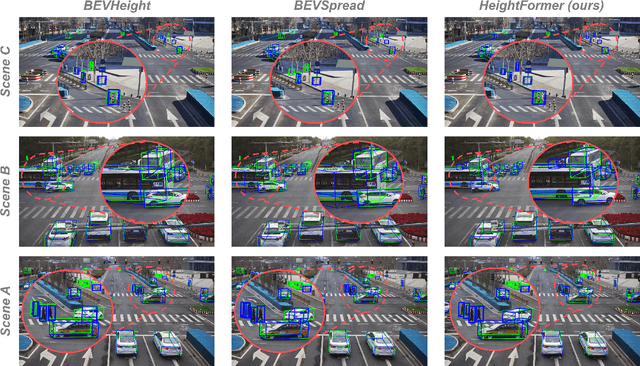
Abstract:Roadside vision centric 3D object detection has received increasing attention in recent years. It expands the perception range of autonomous vehicles, enhances the road safety. Previous methods focused on predicting per-pixel height rather than depth, making significant gains in roadside visual perception. While it is limited by the perspective property of near-large and far-small on image features, making it difficult for network to understand real dimension of objects in the 3D world. BEV features and voxel features present the real distribution of objects in 3D world compared to the image features. However, BEV features tend to lose details due to the lack of explicit height information, and voxel features are computationally expensive. Inspired by this insight, an efficient framework learning height prediction in voxel features via transformer is proposed, dubbed HeightFormer. It groups the voxel features into local height sequences, and utilize attention mechanism to obtain height distribution prediction. Subsequently, the local height sequences are reassembled to generate accurate 3D features. The proposed method is applied to two large-scale roadside benchmarks, DAIR-V2X-I and Rope3D. Extensive experiments are performed and the HeightFormer outperforms the state-of-the-art methods in roadside vision centric 3D object detection task.
HumanoidPano: Hybrid Spherical Panoramic-LiDAR Cross-Modal Perception for Humanoid Robots
Mar 13, 2025Abstract:The perceptual system design for humanoid robots poses unique challenges due to inherent structural constraints that cause severe self-occlusion and limited field-of-view (FOV). We present HumanoidPano, a novel hybrid cross-modal perception framework that synergistically integrates panoramic vision and LiDAR sensing to overcome these limitations. Unlike conventional robot perception systems that rely on monocular cameras or standard multi-sensor configurations, our method establishes geometrically-aware modality alignment through a spherical vision transformer, enabling seamless fusion of 360 visual context with LiDAR's precise depth measurements. First, Spherical Geometry-aware Constraints (SGC) leverage panoramic camera ray properties to guide distortion-regularized sampling offsets for geometric alignment. Second, Spatial Deformable Attention (SDA) aggregates hierarchical 3D features via spherical offsets, enabling efficient 360{\deg}-to-BEV fusion with geometrically complete object representations. Third, Panoramic Augmentation (AUG) combines cross-view transformations and semantic alignment to enhance BEV-panoramic feature consistency during data augmentation. Extensive evaluations demonstrate state-of-the-art performance on the 360BEV-Matterport benchmark. Real-world deployment on humanoid platforms validates the system's capability to generate accurate BEV segmentation maps through panoramic-LiDAR co-perception, directly enabling downstream navigation tasks in complex environments. Our work establishes a new paradigm for embodied perception in humanoid robotics.
S$^2$DN: Learning to Denoise Unconvincing Knowledge for Inductive Knowledge Graph Completion
Dec 20, 2024Abstract:Inductive Knowledge Graph Completion (KGC) aims to infer missing facts between newly emerged entities within knowledge graphs (KGs), posing a significant challenge. While recent studies have shown promising results in inferring such entities through knowledge subgraph reasoning, they suffer from (i) the semantic inconsistencies of similar relations, and (ii) noisy interactions inherent in KGs due to the presence of unconvincing knowledge for emerging entities. To address these challenges, we propose a Semantic Structure-aware Denoising Network (S$^2$DN) for inductive KGC. Our goal is to learn adaptable general semantics and reliable structures to distill consistent semantic knowledge while preserving reliable interactions within KGs. Specifically, we introduce a semantic smoothing module over the enclosing subgraphs to retain the universal semantic knowledge of relations. We incorporate a structure refining module to filter out unreliable interactions and offer additional knowledge, retaining robust structure surrounding target links. Extensive experiments conducted on three benchmark KGs demonstrate that S$^2$DN surpasses the performance of state-of-the-art models. These results demonstrate the effectiveness of S$^2$DN in preserving semantic consistency and enhancing the robustness of filtering out unreliable interactions in contaminated KGs.
Region-Based Optimization in Continual Learning for Audio Deepfake Detection
Dec 16, 2024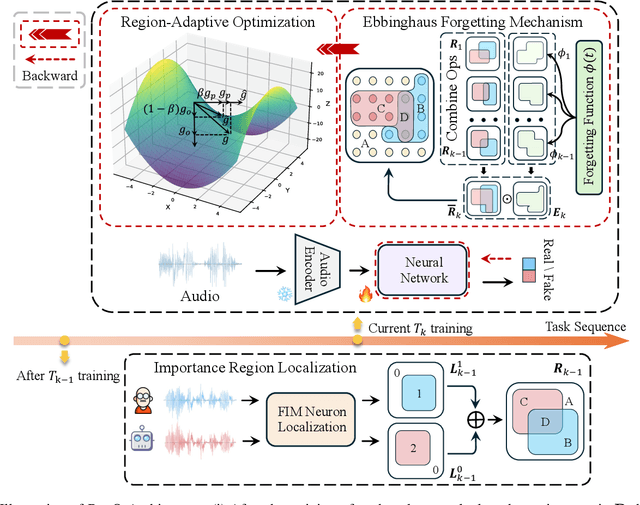
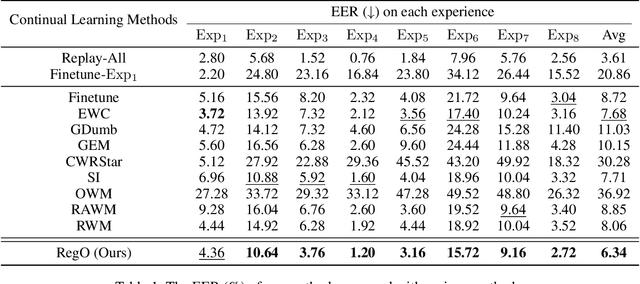

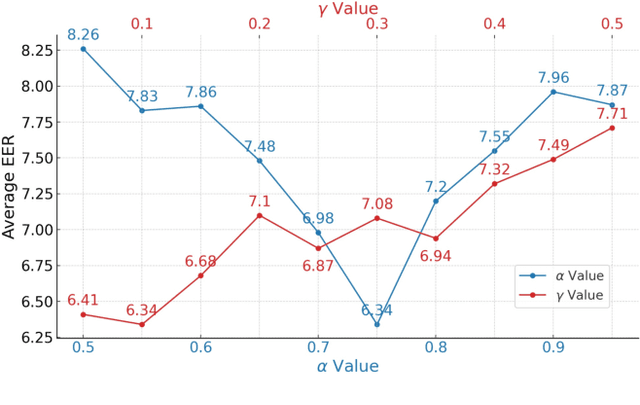
Abstract:Rapid advancements in speech synthesis and voice conversion bring convenience but also new security risks, creating an urgent need for effective audio deepfake detection. Although current models perform well, their effectiveness diminishes when confronted with the diverse and evolving nature of real-world deepfakes. To address this issue, we propose a continual learning method named Region-Based Optimization (RegO) for audio deepfake detection. Specifically, we use the Fisher information matrix to measure important neuron regions for real and fake audio detection, dividing them into four regions. First, we directly fine-tune the less important regions to quickly adapt to new tasks. Next, we apply gradient optimization in parallel for regions important only to real audio detection, and in orthogonal directions for regions important only to fake audio detection. For regions that are important to both, we use sample proportion-based adaptive gradient optimization. This region-adaptive optimization ensures an appropriate trade-off between memory stability and learning plasticity. Additionally, to address the increase of redundant neurons from old tasks, we further introduce the Ebbinghaus forgetting mechanism to release them, thereby promoting the capability of the model to learn more generalized discriminative features. Experimental results show our method achieves a 21.3% improvement in EER over the state-of-the-art continual learning approach RWM for audio deepfake detection. Moreover, the effectiveness of RegO extends beyond the audio deepfake detection domain, showing potential significance in other tasks, such as image recognition. The code is available at https://github.com/cyjie429/RegO
Reject Threshold Adaptation for Open-Set Model Attribution of Deepfake Audio
Dec 02, 2024

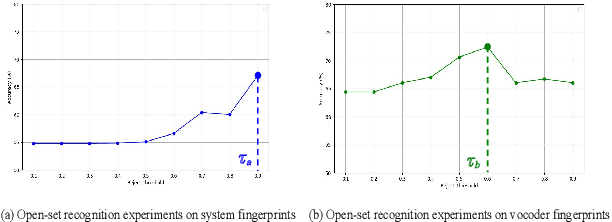

Abstract:Open environment oriented open set model attribution of deepfake audio is an emerging research topic, aiming to identify the generation models of deepfake audio. Most previous work requires manually setting a rejection threshold for unknown classes to compare with predicted probabilities. However, models often overfit training instances and generate overly confident predictions. Moreover, thresholds that effectively distinguish unknown categories in the current dataset may not be suitable for identifying known and unknown categories in another data distribution. To address the issues, we propose a novel framework for open set model attribution of deepfake audio with rejection threshold adaptation (ReTA). Specifically, the reconstruction error learning module trains by combining the representation of system fingerprints with labels corresponding to either the target class or a randomly chosen other class label. This process generates matching and non-matching reconstructed samples, establishing the reconstruction error distributions for each class and laying the foundation for the reject threshold calculation module. The reject threshold calculation module utilizes gaussian probability estimation to fit the distributions of matching and non-matching reconstruction errors. It then computes adaptive reject thresholds for all classes through probability minimization criteria. The experimental results demonstrate the effectiveness of ReTA in improving the open set model attributes of deepfake audio.
A Time Series is Worth Five Experts: Heterogeneous Mixture of Experts for Traffic Flow Prediction
Sep 26, 2024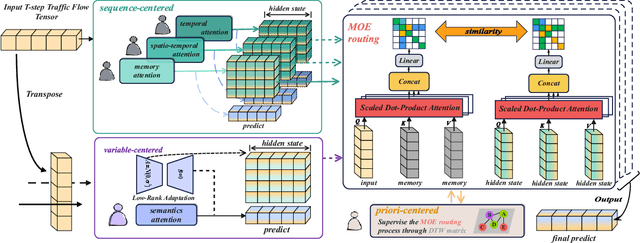
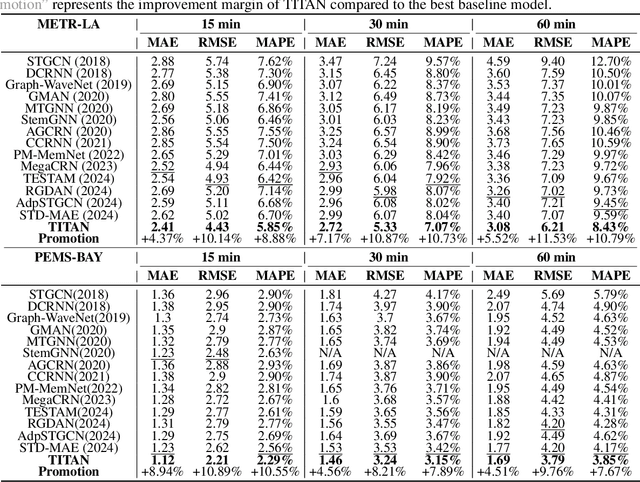


Abstract:Accurate traffic prediction faces significant challenges, necessitating a deep understanding of both temporal and spatial cues and their complex interactions across multiple variables. Recent advancements in traffic prediction systems are primarily due to the development of complex sequence-centric models. However, existing approaches often embed multiple variables and spatial relationships at each time step, which may hinder effective variable-centric learning, ultimately leading to performance degradation in traditional traffic prediction tasks. To overcome these limitations, we introduce variable-centric and prior knowledge-centric modeling techniques. Specifically, we propose a Heterogeneous Mixture of Experts (TITAN) model for traffic flow prediction. TITAN initially consists of three experts focused on sequence-centric modeling. Then, designed a low-rank adaptive method, TITAN simultaneously enables variable-centric modeling. Furthermore, we supervise the gating process using a prior knowledge-centric modeling strategy to ensure accurate routing. Experiments on two public traffic network datasets, METR-LA and PEMS-BAY, demonstrate that TITAN effectively captures variable-centric dependencies while ensuring accurate routing. Consequently, it achieves improvements in all evaluation metrics, ranging from approximately 4.37\% to 11.53\%, compared to previous state-of-the-art (SOTA) models. The code is open at \href{https://github.com/sqlcow/TITAN}{https://github.com/sqlcow/TITAN}.
 Add to Chrome
Add to Chrome Add to Firefox
Add to Firefox Add to Edge
Add to Edge